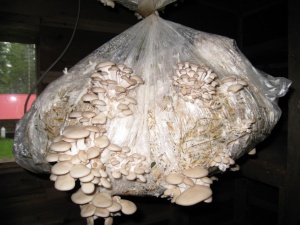Oyster Mushrooms
Oyster mushrooms have so many nutritive and medicinal properties that are they are too numerous for me to reproduce here now. I'll build up as they are referenced in questions/episodes, but suffice to say, these little guys are going to [continue to] save lives in the times ahead.
Mushrooms have been used throughout history as well for medicinal applications.
Contents
Nutrition
- Great source of Vitamin D -- and one that requires no sunlight, and can be grown year-round.
- Anti-oxident
Benefits
There are many benefits and medicinal properties:
Immune System Support
(A huge bonus, especially as we enter what is historically a period of epidemic and suppressed immune systems:)
One of the most significant beneficial effects to one’s health when consuming mushrooms comes from the ability of oyster mushrooms to both enhance one’s immune system as well as improve its regulation. So both those who wish to strengthen their immune system to fight cancer or infectious illnesses and those individuals suffering from autoimmune disorders or allergies can benefit.
Antimicrobial
Research has shown oyster mushrooms to be effective against drug resistant E. coli and Staph. infections. Studies have also shown it to be effective against Candida overgrowth and Streptococcus or Enterococcus infections.
Antiviral
Oyster mushrooms can exert both direct and indirect antiviral effects through immune system-enhancing activity. Ubiquitin is an antiviral protein isolate from oyster mushrooms. The mushroom also has potential to inhibit cell replication in viruses including HIV.
Anti-Cancer
Polysaccharides within the oyster mushrooms have shown potent anti-tumor activity in both in-vitro and animal studies. One specific antioxidant – polysaccharide pleuran – has shown promise in combating colon cancer. Other anti-cancer effects of the oyster mushroom come from its ability to reduce DNA damage through multiple mechanisms.
Lowers Blood Sugar
High blood sugar is a hallmark of type I and type II diabetes. The high fiber and beneficial protein content along with the low-fat content of mushrooms make them an ideal food for any individual wishing to combat diabetes naturally. Guanide, a compound contained in oyster mushrooms, exerts a powerful anti-hyperglycemic effect, naturally lowering blood sugar levels.
From Mushrooms Modulate Blood Sugar:
Extracts of American oyster and abalone mushrooms beneficially impact insulin levels, among diabetic men and women.
Low in calories, fat-free, cholesterol-free and very low in sodium, mushrooms promote healthy weight, boost immune function, and serve as a convenient way to achieve Vitamin D levels.
Oyster mushroom extract reduced fasting glucose by 6.1% and post-meal glucose by 16.4%
All of these claims are supported by science, but particularly these diabetic ones I want to source specific studies here:
- Oyster Mushrooms have been shown to reduced blood glucose and cholesterol in diabetic subjects.
- Especially helpful for folks with type 2.
Lowers Blood Pressure
Oyster mushrooms have been found to have a relaxation effect on the smooth muscle of the arterial walls, thus effectively lowering blood pressure.
Anti-inflammatory
Oyster mushrooms have been shown to have an anti-inflammatory effect within the body by down-regulating pro-inflammatory pathways involved in both chronic (autoimmune etc.) and acute (allergies, tissue injury) type hyper-inflammatory conditions.
Sourcing
These dowels did work for me. As mentioned in the videos (including episode 1), I sterilized (boiled) straw before inoculating with the dowel spawn.
- These dowels I recommend are available here: Oyster Mushroom Mycelium
I've also heard from listeners that inoculating logs should give 3-4 years of fruiting mushrooms, yet often they'll get as many as 6 years of good production. So maybe that's a better way to go than boiling bags of straw...
Cycle
The cycle is LONG -- it can take 3-6-9 months after inoculating a medium depending on conditions before actually yielding fruit (mushrooms). Bear in mind then, that to keep a constant production of mushrooms -- if this is even feasible given that they will only fruit in certain temperatures! -- would require a significant investment into building up a pipeline for months, before collecting any yield.
Any feedback here?
This project took so long to complete, that my data is not flawless on timeline. Sorry for the sloppy write-up; hope to improve soon.
Here is a first video
And a second video
Months later (9/11/2017), I awoke to find that mushrooms had fruited out of one of the bags. Perhaps it is because it's finally getting cool at night? I cut open the other bags to try to encourage fruiting there too, as the mycelium has fully colonized the medium, but nothing much has happened.
Indeed, within a couple days, another bag had fruited:
